Home » Solar physics
Category Archives: Solar physics
Current state and perspectives of Space Weather science in Italy
Papers from SWICo members
Plainaki Christina, Antonucci Marco, Bemporad Alessandro, Berrilli Francesco, Bertucci Bruna, Castronuovo Marco, De Michelis Paola, Giardino Marco, Iuppa Roberto, Laurenza Monica, Marcucci Federica, Messerotti Mauro, Narici Livio, Negri Barbara, Nozzoli Francesco, Orsini Stefano, Romano Vincenzo, Cavallini Enrico, Polenta Gianluca, Ippolito Alessandro
This paper presents a brief state-of-the-art in Space Weather science in Italy and discuss some ideas on a long-term plan for the support of future scientific research in the related disciplines. Italian teams contributed in the advancing of our knowledge on the properties and evolution of the Space Weather phenomena with observational campaigns from space and from the ground. Numerous Space Weather forecasting and now-casting modeling efforts have resulted in a remarkable add-on to the overall progress in the field, at both national and international level. The Italian Space Agency participated several times in space missions related to Space Weather; indeed, the development of new instrumentation for future Heliophysics and Space Weather space missions will be very important for the Italian scientific and industrial communities.
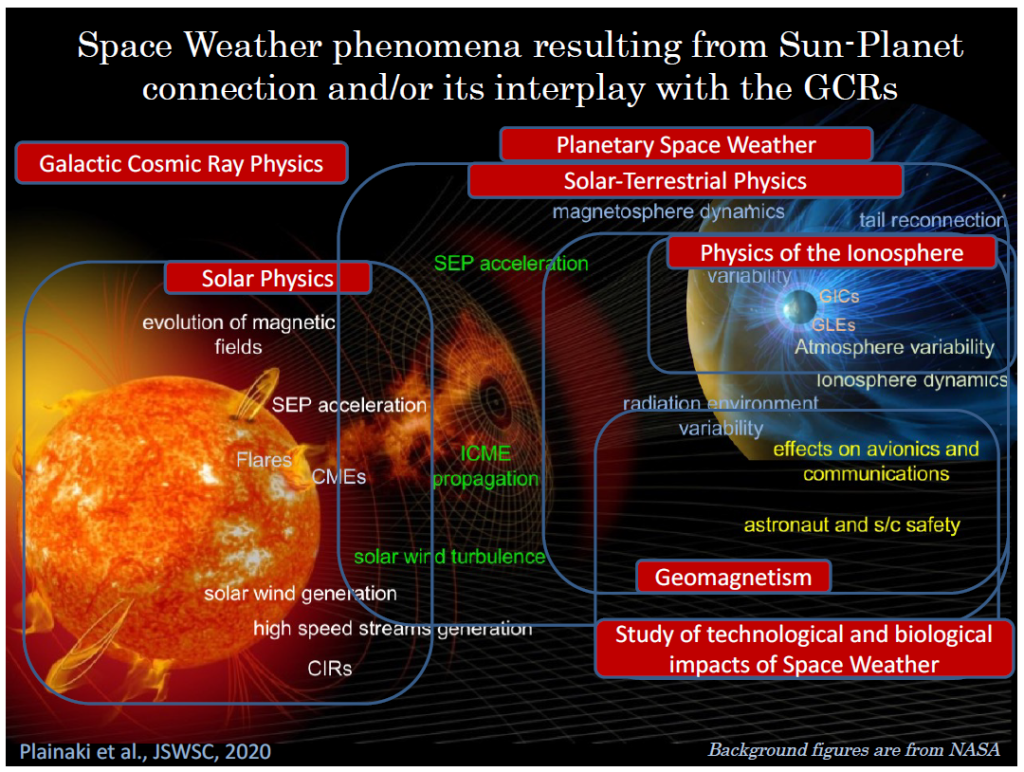
The Italian Space Agency aims to assess the possibility to develop a national scientific Space Weather data centre to encourage synergies between different science teams with interest in the field and to motivate innovation and new mission concept development. Alongside with the proposed recommendations, this paper also discusses how the Italian expertise could complement international efforts in a wider international Space Weather context.
Publication: Plainaki C., Antonucci M., Bemporad A., Berrilli F., Bertucci B., Castronuovo M., De Michelis P., et al., 2020, JSWSC, 10, 6. doi:10.1051/swsc/2020003. https://www.swsc-journal.org/articles/swsc/abs/2020/01/swsc190014/swsc190014.html
Flare-forecasting Algorithms Based on High-gradient Polarity Inversion Lines in Active Regions
Papers from SWICo members
Domenico Cicogna, Francesco Berrilli, Daniele Calchetti, Dario Del Moro, Luca Giovannelli, Federico Benvenuto, Cristina Campi, Sabrina Guastavino, Michele Piana
Solar flares emanate from solar active regions hosting complex and strong bipolar magnetic fluxes. Estimating the probability of an active region to flare and defining reliable precursors of intense flares are extremely challenging tasks in the space weather field. In this work, we focus on two metrics as flare precursors, the unsigned flux R, tested on Michelson Doppler Imager/Solar and Heliospheric Observatory data, one of the most used parameters for flare-forecasting applications, and a novel topological parameter D, representing the complexity of a solar active region.
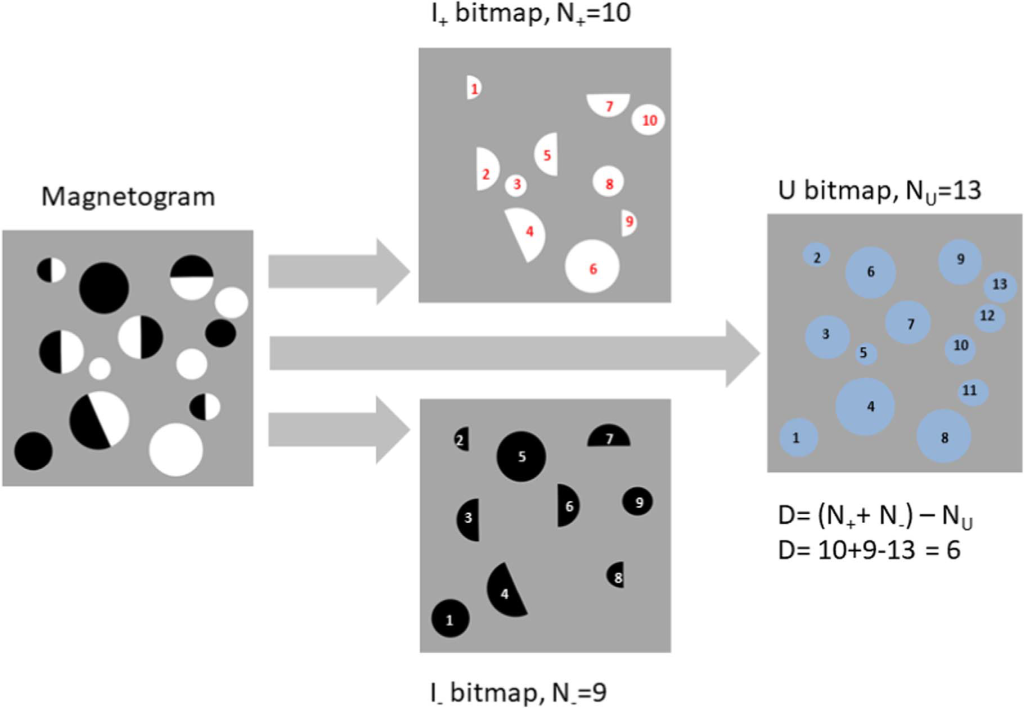
We use both a heuristic approach and a supervised machine-learning method to validate the effectiveness of these two descriptors to predict the occurrence of X- or M-class flares in a given solar active region during the following 24 hr period. Our feature ranking analysis shows that both parameters play a significant role in prediction performances. Moreover, the analysis demonstrates that the new topological parameter D is the only one, among 173 overall predictors, that is always present for all test subsets and is systematically ranked within the top 10 positions in all tests concerning the computation of the weights with which each predictor impacts the flare forecasting.
Publication: Cicogna D., Berrilli F., Calchetti D., Del Moro D., Giovannelli L., Benvenuto F., Campi C., et al., 2021, ApJ, 915, 38. doi:10.3847/1538-4357/abfafb. https://iopscience.iop.org/article/10.3847/1538-4357/abfafb
Data reduction pipeline for MOF-based synoptic telescopes
Papers from SWICo members
Roberta Forte, Francesco Berrilli, Daniele Calchetti, Dario Del Moro, Bernhard Fleck, Cynthia Giebink, William Giebink, Luca Giovannelli, Stuart Mark Jefferies, Allister Knox, Maria Magrì, Neil Murphy, Garry Nitta, Maurizio Oliviero, Ermanno Pietropaolo, Wayne Rodgers, Stefano Scardigli, Giorgio Viavattene
The synoptic telescopes based on Magneto Optical Filters (MOF) using different lines are capable of measuring the line-of-sight Doppler velocity and magnetic field over the full solar disk at different ranges of height in the Sun’s photosphere and low chromosphere. Instruments like the MOTH (Magneto-Optical filters at Two Heights), using a dual-channel based on MOFs operating at 589.0 nm (Na D2 line) and 769.9 nm (K D1 line), the VAMOS instrument (Velocity And Magnetic Observations of the Sun), operating at 769.9 nm (K D1 line), and the future TSST (Tor Vergata Synoptic Solar Telescope), using a dual-channel telescope operating at 656.28 nm (H-alpha line) and at 769.9 nm (K D1 line), allow to face both aspects, the scientific and the operative related to Space Weather applications.
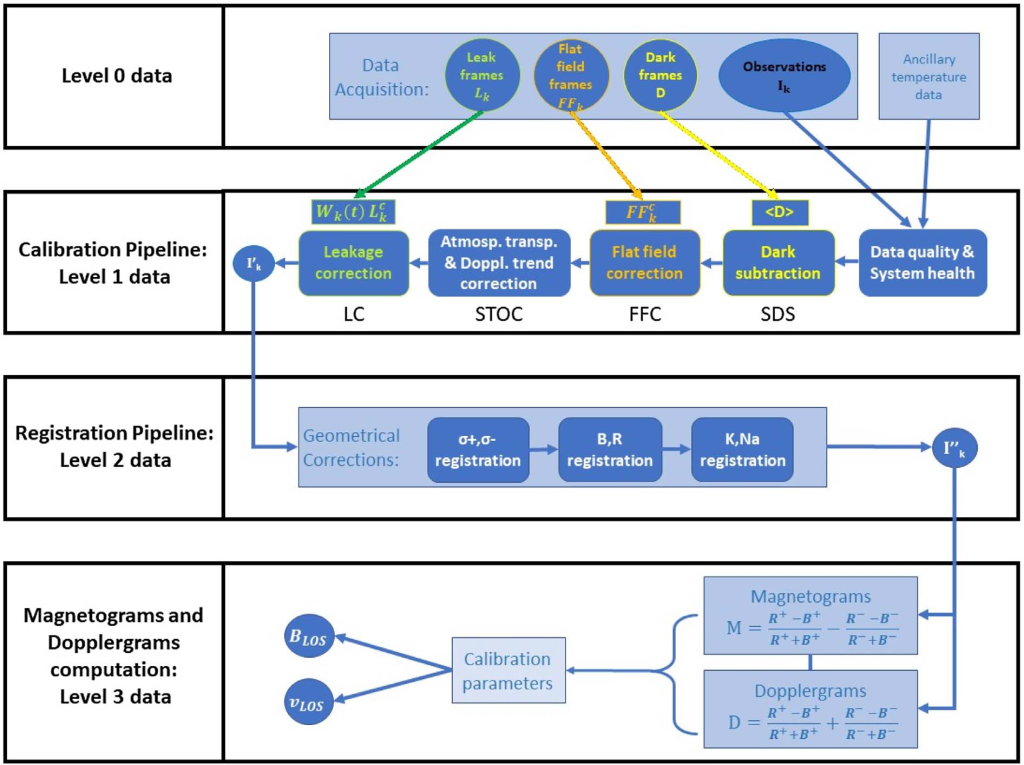
The MOTH, VAMOS and TSST data enable a wide variety of studies of the Sun, from seismic probing of the solar interior (sound speed, rotation, details of the tachocline, sub-surface structure of active regions), to the dynamics and magnetic evolution of the lower part of the solar atmosphere (heating of the solar atmosphere, identification of the signatures of solar eruptive events, atmospheric gravity waves, etc.), to the 3D reconstruction of the solar atmosphere and flare locations. However, the use of MOF filters requires special care in calibrating the data for scientific or operational use. This work presents a systematic pipeline that derives from the decennial use of MOF’s technology. More in detail, the pipeline is based on data reduction procedures tested and validated on MOTH data acquired at Mees Solar Observatory of the University of Hawaii Haleakala Observatories and at South Pole Solar Observatory (SPSO), at the Amundsen-Scott South Pole Station in Antarctica, during Antarctica Summer Campaign 2016/17.
Publication: Forte R., Berrilli F., Calchetti D., Del Moro D., Fleck B., Giebink C., Giebink W., et al., 2020, JSWSC, 10, 63. doi:10.1051/swsc/2020065. https://www.swsc-journal.org/articles/swsc/full_html/2020/01/swsc200064/swsc200064.html
The Tor Vergata Synoptic Solar Telescope (TSST): A robotic, compact facility for solar full disk imaging
Papers from SWICo members
Luca Giovannelli, Francesco Berrilli, Daniele Calchetti, Dario Del Moro, Giorgio Viavattene, Ermanno Pietropaolo, Marco Iarlori, Vincenzo Rizi, Stuart Mark Jefferies, Maurizio Oliviero, Luciano Terranegra, Neil Murphy
By the continuous multi-line observation of the solar atmosphere, it is possible to infer the magnetic and dynamical status of the Sun. This activity is essential to identify the possible precursors of space weather events, such as flare or coronal mass ejections. We describe the design and assembly of TSST (Tor Vergata Synoptic Solar Telescope), a robotic synoptic telescope currently composed of two main full-disk instruments, a Hα telescope and a Potassium (KI D1) magneto-optical filter (MOF)-based telescope operating at 769.9 nm.
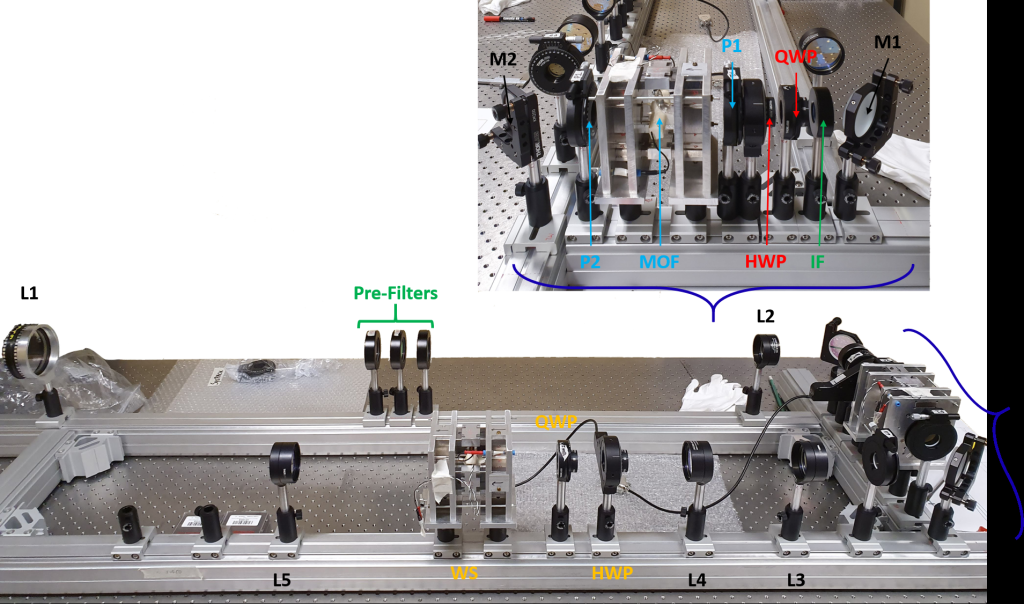
TSST is designed to be later upgraded with a second MOF channel. This paper describes the TSST concepts and presents the first light observation carried out in February 2020. We show that TSST is a low-cost robotic facility able to achieve the necessary data for the study of precursors of space weather events (using the magnetic and velocity maps by the MOF telescope) and fast flare detection (by the Hα telescope) to support Space Weather investigation and services.
Publications: Giovannelli L., Berrilli F., Calchetti D., Del Moro D., Viavattene G., Pietropaolo E., Iarlori M., et al., 2020, JSWSC, 10, 58. doi:10.1051/swsc/2020061. https://www.swsc-journal.org/articles/swsc/full_html/2020/01/swsc200063/swsc200063.html
Daniele Calchetti, Giorgio Viavattene, Luciano Terranegra, Ermanno Pietropaolo, Maurizio Oliviero, Neil Murphy, Start M. Jefferies, Luca Giovannelli, Dario Del Moro, and Francesco Berrilli, Proc. SPIE 11445, Ground-based and Airborne Telescopes VIII, 114452T (13 December 2020); https://doi.org/10.1117/12.2562454
Calchetti D, Viavattene G, Berrilli F, Del Moro D, Giovannelli L, Oliviero M. 2020. Journal of Physics Conference Series, Vol. 1548. https://doi.org/10.1088/1742-6596/1548/1/012005
Viavattene G, Calchetti D, Berrilli F, Del Moro D, Giovannelli L, Pietropaolo E, Oliviero M, Terranegra L. 2020. Il Nuovo
Ciment C (Ed.), Vol. 43 of Il Nuovo Cimento C, 120 p. https://doi.org/10.1393/ncc/i2020-20120-6
Magnetic Energy Balance in the Quiet Sun on Supergranular Spatial and Temporal Scales
Papers from SWICo members
F. Giannattasio, G. Consolini, F. Berrilli, and D. Del Moro
Small-scale magnetic fields are ubiquitous in the quiet solar photosphere and may store and transfer huge amounts of energy to the upper atmospheric layers giving rise to a chain of phenomena that are relevant for Space Weather. For this reason, it is fundamental to constrain the energetics of the quiet Sun.
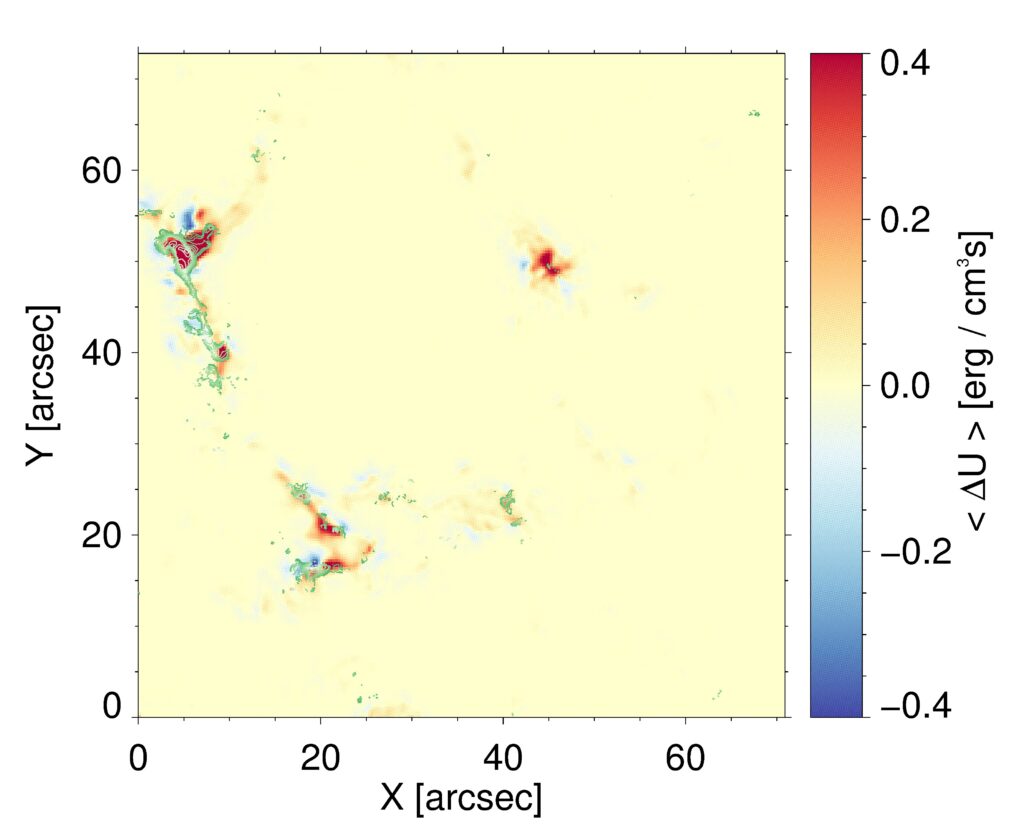
By taking advantage of a 24 hr long with 90 s cadence magnetogram time series acquired by the Hinode mission without interruption, we computed, for the first time, the average photospheric electric field, the average current density, and starting from these, the rate of change of magnetic energy density on supergranular spatial and temporal scales. The main result is that, on average, the energy provided by photospheric electric and magnetic fields and current density can sustain the magnetic fields in the network.
Publication: F. Giannattasio, G. Consolini, F. Berrilli, and D. Del Moro, Magnetic Energy Balance in the Quiet Sun on Supergranular Spatial and Temporal Scales, The Astrophysical Journal, 904, 1, 2020.
https://doi.org/10.3847/1538-4357/abbb36
Detection Capability of Flux Ropes during the Solar Orbiter Mission
Papers from SWICo members
Telloni, Daniele; D’Amicis, Raffaella; Bruno, Roberto; Carbone, Francesco; Perrone, Denise; Zank, Gary P.; Zhao, Lingling; Nakanotani, Masaru; Adhikari, Laxman
Flux ropes are interplanetary magnetic helical structures that are receiving increasing attention because of their likely role in magnetohydrodynamic (MHD) processes as well as their impact on space weather science. A very promising and powerful approach to address their investigation and characterization is based on wavelet spectrograms of the invariants of the ideal MHD equations.
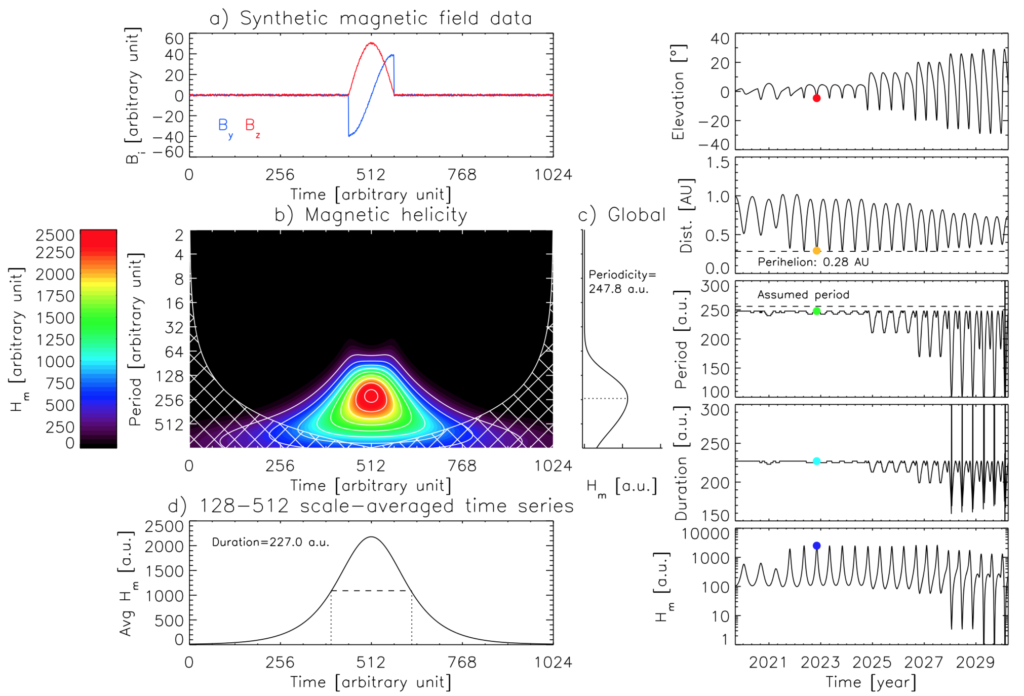
The accuracy of this method to infer flux rope properties depends on the proper evaluation of the direction of propagation of the flux rope itself, which is often difficult to assess. We present a numerical test of the reliability of this diagnostic technique, by simulating a synthetic flux rope of fixed size and propagation direction along the Solar Orbiter orbit, that is very elongated and inclined with respect to the orbital plane. We find that when the flux rope is crossed for less than 50% of its width, the procedure becomes unreliable. Quantitative information on how to properly recover the flux-rope intrinsic properties is provided.
Publication: Telloni D., D’Amicis R., Bruno R., Carbone F., Perrone D., Zank G. P., Zhao L., et al., 2020, ApJL, 899, L25.
https://iopscience.iop.org/article/10.3847/2041-8213/abacc4
Study of the Influence of the Solar Wind Energy on the Geomagnetic Activity for Space Weather Science
Papers from SWICo members
Telloni, Daniele; Carbone, Francesco; Antonucci, Ester; Bruno, Roberto; Grimani, Catia; Villante, Umberto; Giordano, Silvio; Mancuso, Salvatore; Zangrilli, Luca
This paper addresses the investigation of the interaction of the solar wind energy with the Earth’s magnetosphere, by studying its correlation with the disturbance storm time (Dst) index, a proxy of the geomagnetic activity. Some relevant parameters of the solar wind (the bulk speed and the z-component of the interplanetary magnetic field) are explored in the energy-Dst space.
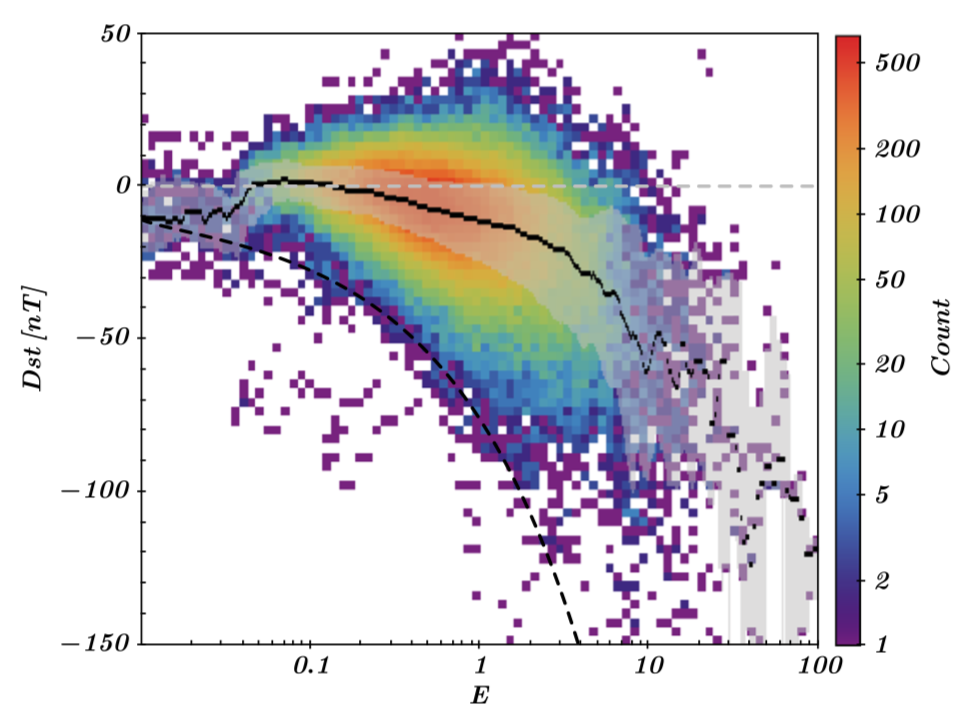
It results that (I) the solar wind energy and the geomagnetic activity are strictly related, with the coronal mass ejections representing the most energetic and geoeffective driver; (II) the slow solar wind has negligible effects on Earth regardless of its energy content, whereas high-speed streams may induce severe geomagnetic storming depending on the advected energy; and (III) while at low and mid energies, geomagnetic disturbances are induced provided the magnetic reconnection between the interplanetary and terrestrial magnetic fields occurs, high-energy solar wind plasma can impact Earth even without reconnecting with the geomagnetic field at the dayside magnetopause. The most significant result in the framework of space weather science resides in the observational evidence that the Earth’s magnetosphere has a maximum response to the energetic content of the solar wind, which leads to the derivation of an empirical law allowing the proper forecast of the upper limit of the intensity of any geomagnetic disturbance on the basis of the solar wind energy derived in situ at the Lagrangian point L1.
Publication: Telloni D., Carbone F., Antonucci E., Bruno R., Grimani C., Villante U., Giordano S., et al., 2020, ApJ, 896, 149.
https://iopscience.iop.org/article/10.3847/1538-4357/ab91b9/pdf
Detection of Coronal Mass Ejections at L1 and Forecast of Their Geoeffectiveness
Papers from SWICo members
Daniele Telloni , Ester Antonucci, Alessandro Bemporad, Tiziano Bianchi, Roberto Bruno, Silvano Fineschi, Enrico Magli, Gianalfredo Nicolini, and Roberto Susino
A novel tool aimed to detect solar coronal mass ejections (CMEs) at the Lagrangian point L1 and to forecast their geoeffectiveness is presented in this paper. This approach is based on the analysis of in situ magnetic field and plasma measurements to compute some important magnetohydrodynamic quantities of the solar wind (the total pressure, the magnetic helicity, and the magnetic and kinetic energy), which are used to identify the CME events, that is their arrival and transit times, and to assess their likelihood for impacting the Earths magnetosphere.
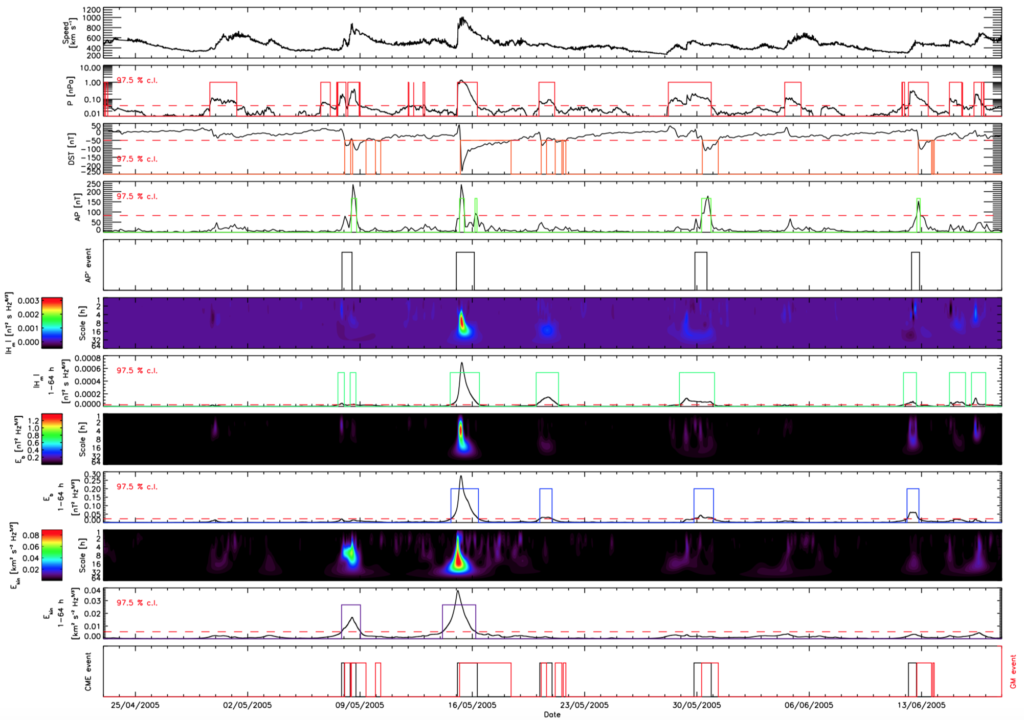
The method is essentially based on the comparison of the topological properties of the CME magnetic field configuration and of the CME energetic budget with those of the quasi-steady ambient solar wind. The algorithm performances are estimated by testing the tool on solar wind data collected in situ by the Wind spacecraft from 2005 to 2016. In the scanned 12 yr time interval, it results that (i) the procedure efficiency is of 86% for the weakest magnetospheric disturbances, increasing with the level of the geomagnetic storming, up to 100% for the most intense geomagnetic events, (ii) zero false positive predictions are produced by the algorithm, and (iii) the mean delay between the potentially geoeffective CME detection and the geomagnetic storm onset if of 4 hr, with a 98% 2-8 hr confidence interval. Hence, this new technique appears to be very promising in forecasting space weather phenomena associated to CMEs.
Publication: Telloni D., Antonucci E., Bemporad A., Bianchi T., Bruno R., Fineschi S., Magli E., et al., 2019, ApJ, 885, 120. doi:10.3847/1538-4357/ab48e9
https://iopscience.iop.org/article/10.3847/1538-4357/ab48e9/pdf
Continuum Enhancements, Line Profiles, and Magnetic Field Evolution during Consecutive Flares
Papers from SWICo members
Zuccarello, Francesca; Guglielmino, Salvo L.; Capparelli, Vincenzo; Mathioudakis, Mihalis; Keys, Peter H.; Criscuoli, Serena; Falco, Mariachiara; Murabito, Mariarita
The occurrence of very energetic solar flares can give rise to Space Weather phenomena impacting on the circum-terrestrial environment.It is well known that, during solar flares, magnetic energy can be converted into electromagnetic radiation from radio waves to γ-rays. Enhancements in the continuum at visible wavelengths, as well as continuum enhancements in the FUV and NUV passbands, give rise to the so-called white-light (WL) flares. Moreover, the strong energy release taking place during these events can lead to the rearrangement of the magnetic field at the photospheric level, causing morphological changes in sunspots.

In this paper, we describe the results of the analysis performed using data acquired by satellite instruments (Interface Region Imaging Spectrograph (IRIS), Solar Dynamics Observatory/Helioseismic and Magnetic Imager, Hinode/Solar Optical Telescope) and ground-based telescopes (Rapid Oscillations in the Solar Atmosphere (ROSA)/Dunn Solar Telescope) during two consecutive C7.0 and X1.6 flares (accompanied by an eruption) that occurred in active region NOAA 12205 on 2014 November 7. The analysis shows the presence of continuum enhancements during the evolution of the events, observed both in ROSA images and in IRIS spectra. We also investigate the role played by the evolution of the δ sunspots in the flare triggering, as well as the changes in the penumbrae surrounding these sunspots as a further consequence of these flares.
Publication: Zuccarello F., Guglielmino S. L., Capparelli V., Mathioudakis M., Keys P. H., Criscuoli S., Falco M., et al., 2020, ApJ, 889, 65. doi:10.3847/1538-4357/ab621f
https://iopscience.iop.org/article/10.3847/1538-4357/ab621f/pdf
Can superflares occur on our Sun?
Papers from SWICo members
Authors:
Paolo Romano, Abouazza Emhamdi, Ayman Kordi
Two strong homologous white light flares of X-GOES class occurred on the Sun on Sept. 06, 2017, providing a rare exceptional opportunity to study the mechanisms responsible for the formation of the magnetic field configurations suitable for the manifestation of such yet enigmatic eruptive events and their effects in the lower layers of the solar atmosphere.
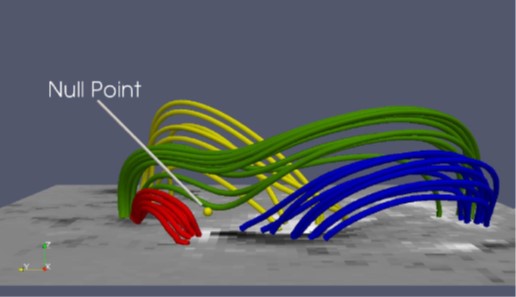
Using photospheric vector magnetograms, taken before the beginning of the two X-class events, as boundary conditions to reconstruct the non−linear coronal magnetic field configuration, we identified two related 3D null points located at low heights above the photosphere (i.e. in very low corona). These null points are most likely responsible for the triggering of the two strong X-GOES class flares. We deduced that their formation at such low altitudes may plausibly be ascribed to the peculiar photospheric horizontal motions of the main magnetic structures of the hosting Active Region NOAA 12673.
These events can be adopted as a hint for a possible interpretation of the activity of young G-type stars, recently reported by the Kepler mission, and can shed light on the probability that superflares occur on our Sun.
Publication: Two Strong White-Light Solar Flares in AR NOAA 12673 as Potential Clues for Stellar Superflares, Solar Physics, 294, 4, 2019
https://link.springer.com/article/10.1007/s11207-018-1388-0
